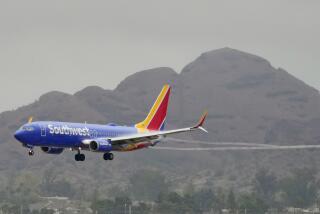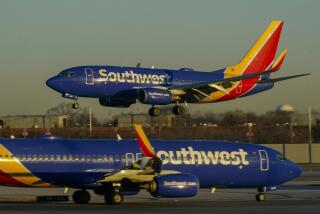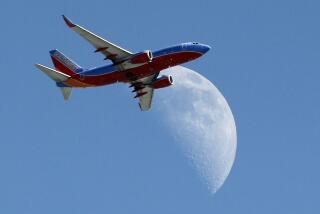Southwest cuts cabin service short to reduce risk of injuries, airline says

- Share via
Tray tables up already?
Southwest fliers need to prepare for landing about 10 minutes earlier than usual in a change that the airline says is rooted in keeping passengers safe — but which also may cut into cabin service time.
The airline confirmed to The Times that the change in procedure began Wednesday but did not respond to questions on how it might affect food and drink service on shorter flights such as between Los Angeles and San Francisco or Las Vegas — which take about an hour and a half.
Flights that are even shorter, such as those among the Hawaiian Islands that last from 20 to 40 minutes, might lose access to any drink service at all, including for water, according to Beat of Hawaii travel news. (You can still buy drinks to bring on board or fill a reusable water bottle before departure.)
Southwest flight attendants “will begin preparing the cabin for landing at an altitude of 18,000 feet beginning Dec. 4. The change in procedures is designed to reduce the risk of in-flight turbulence injuries for our Crew Members and Customers,” the airline wrote in a statement.
Previously, landing preparation began at 10,000 feet, the airline said.
In-flight turbulence caused one death and two dozen injuries during a Singapore Airlines flight earlier this year that descended 6,000 feet in about three minutes.
Videos of turbulence from inside plane cabins have gone viral over the last year. A Scandinavian Airlines plane headed for Miami left passengers screaming as drinks and loose objects jerked into the air as the plane shook. The plane made an emergency landing in Greenland and headed back to Europe. No injuries were reported during that flight.
Deaths due to turbulence are exceedingly rare, and flying remains statistically safer than ever, according to a recent MIT study.
Increasingly frequent incidents of turbulence during passenger flights could be due to climate change, some meteorologists and aviation experts say.
Instances of moderate or more violent clear-air turbulence have increased by 37% over the north Atlantic Ocean over the last 40 years, according to a 2023 study analyzing data from 1979 to 2020. Turbulence can cause injuries in passengers and airline employees, along with wear and tear on airplanes, the study notes.
The FAA advises passengers to stay buckled in their seats at all times, not just when required during landing and takeoff, to avoid injuries from unexpected turbulence. The agency uses technology to understand weather patterns and helps pilots avoid bad winds with a “nowcast” system that provides 15-minute updates on turbulence forecasts.
More to Read
Sign up for Essential California
The most important California stories and recommendations in your inbox every morning.
You may occasionally receive promotional content from the Los Angeles Times.










